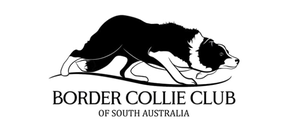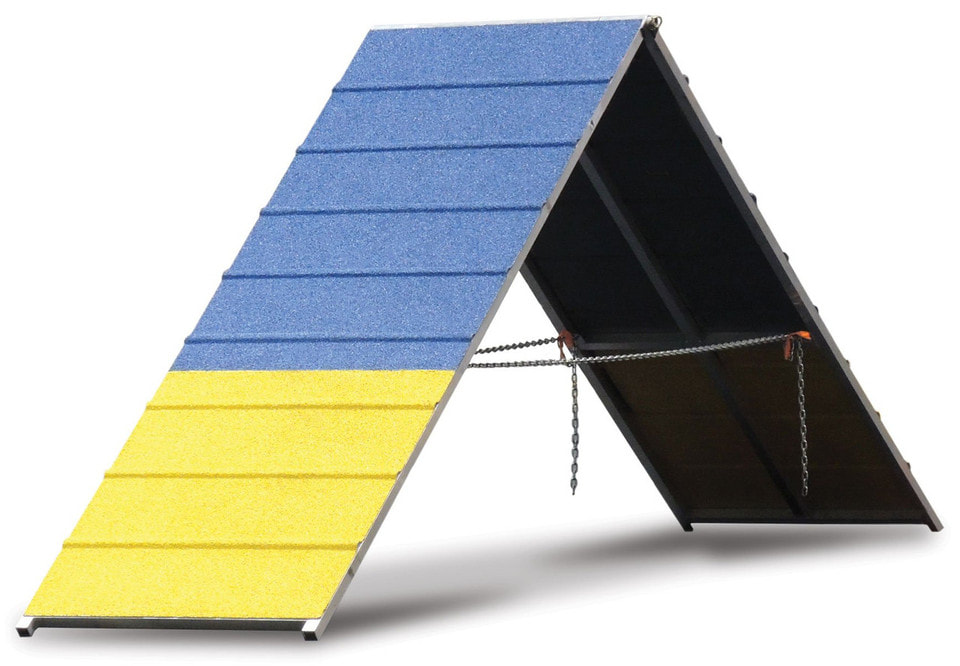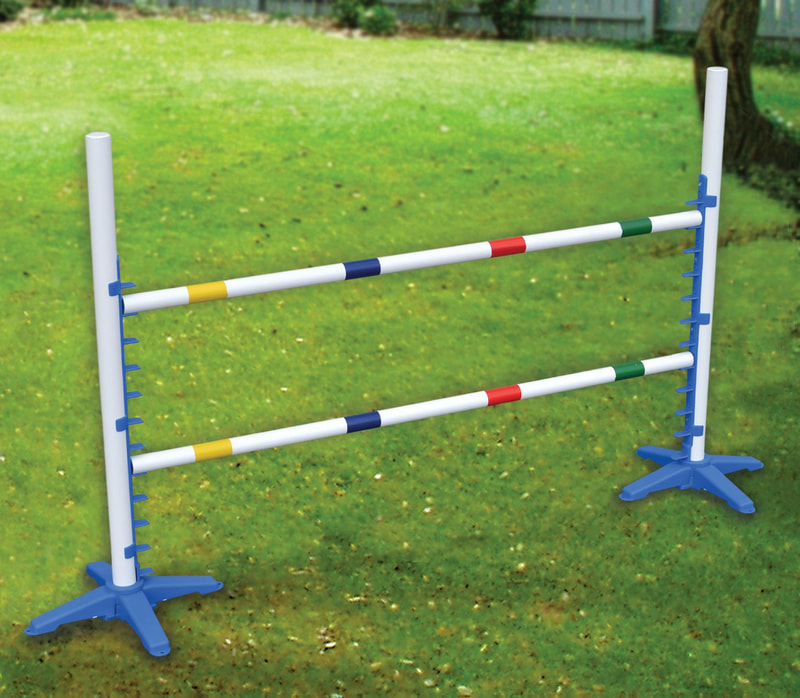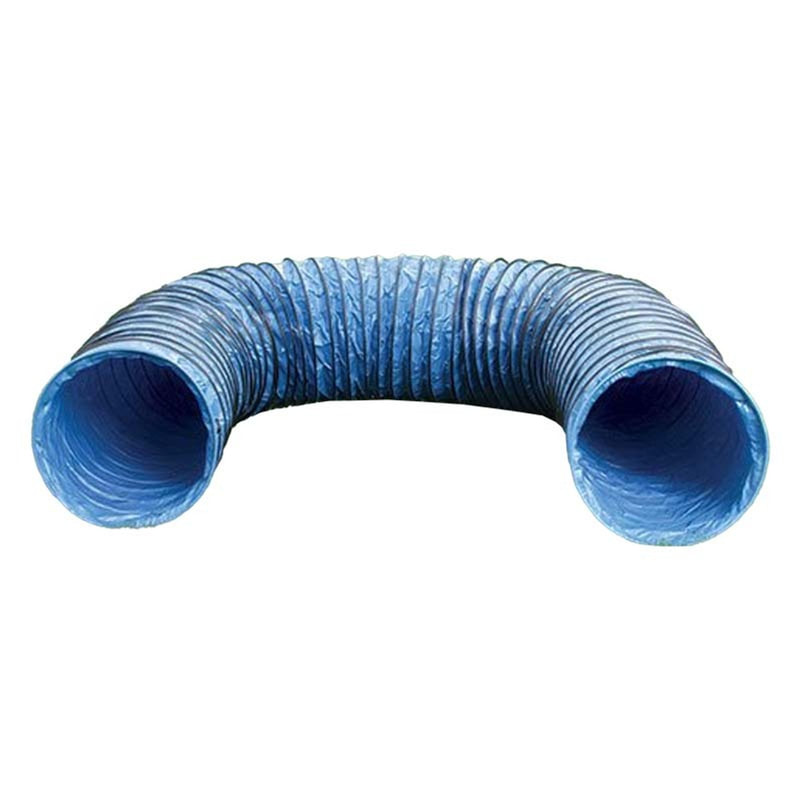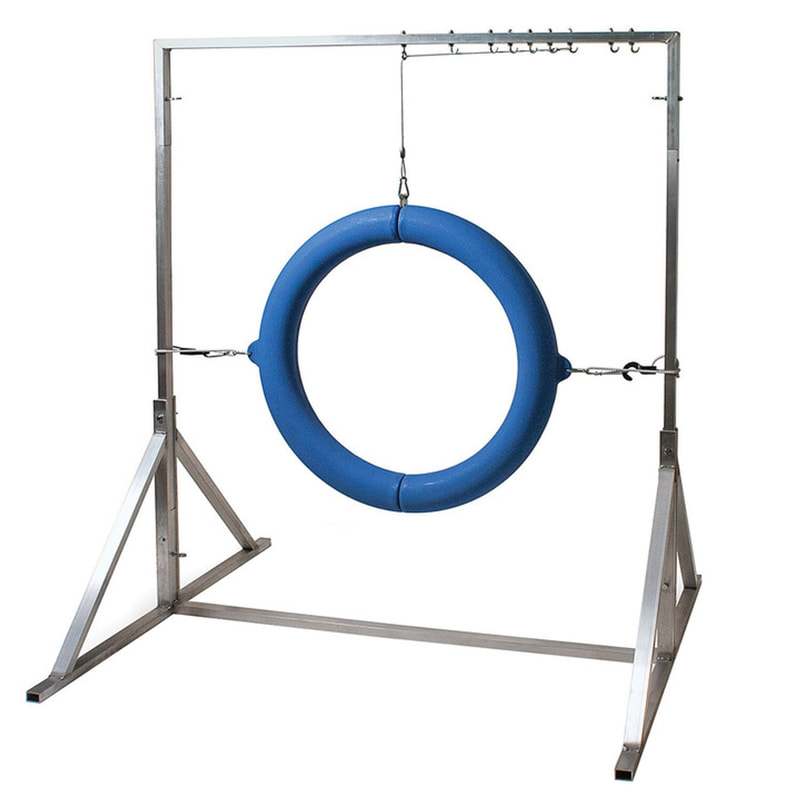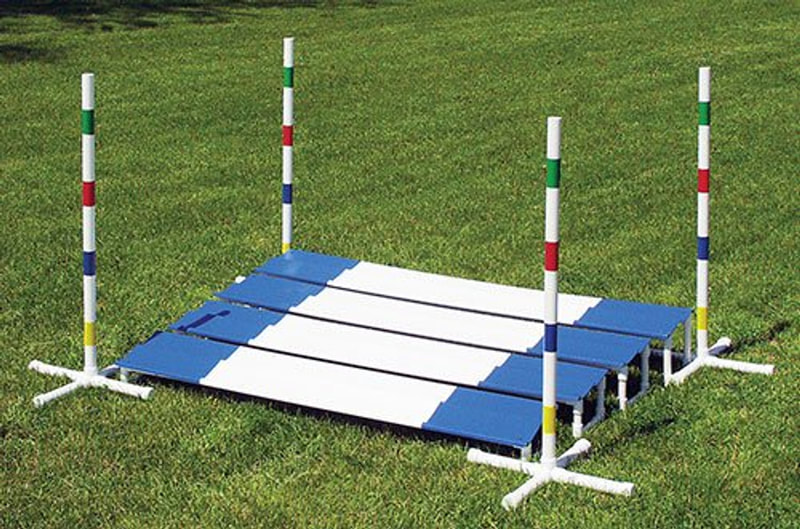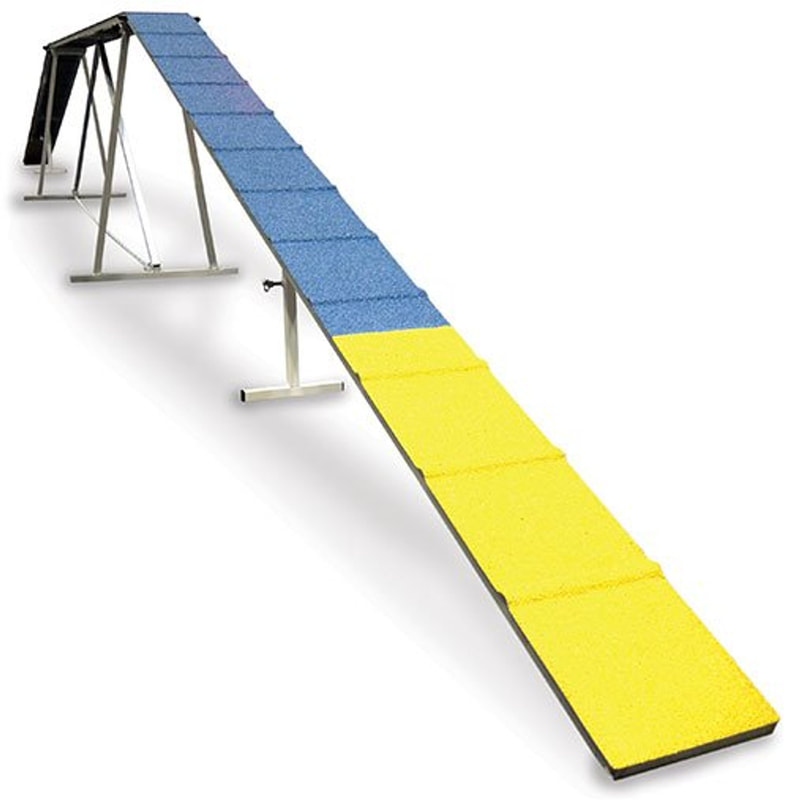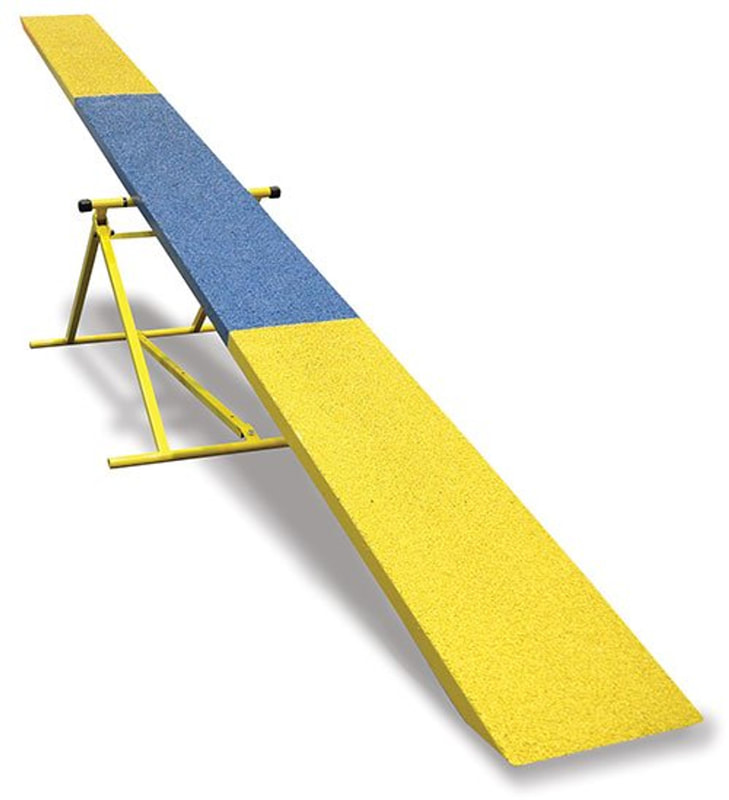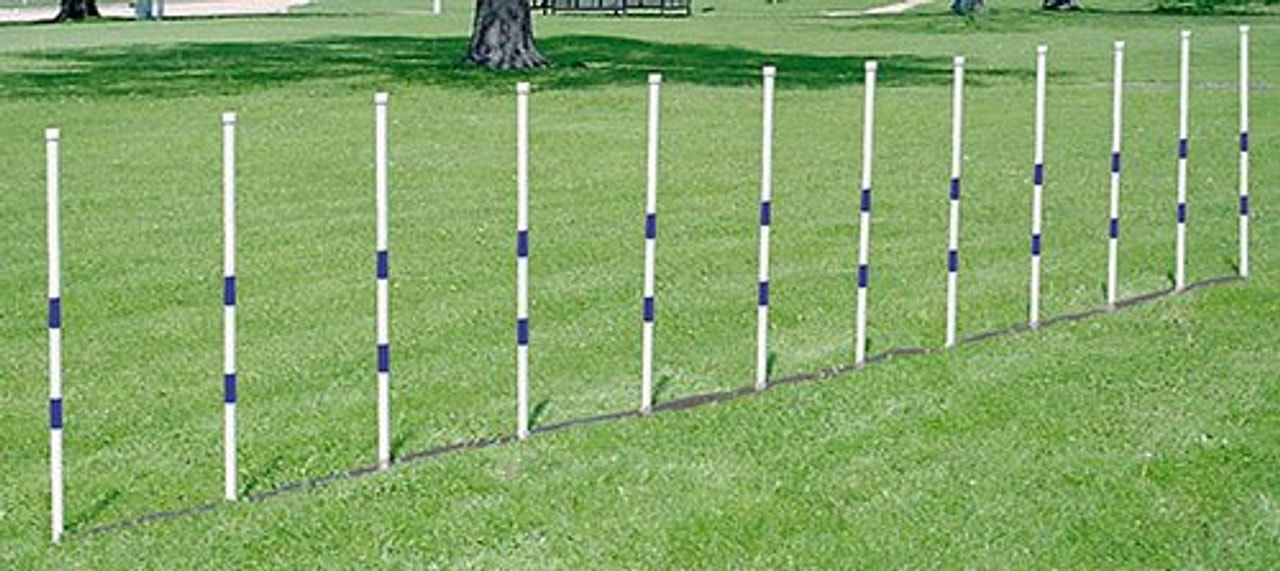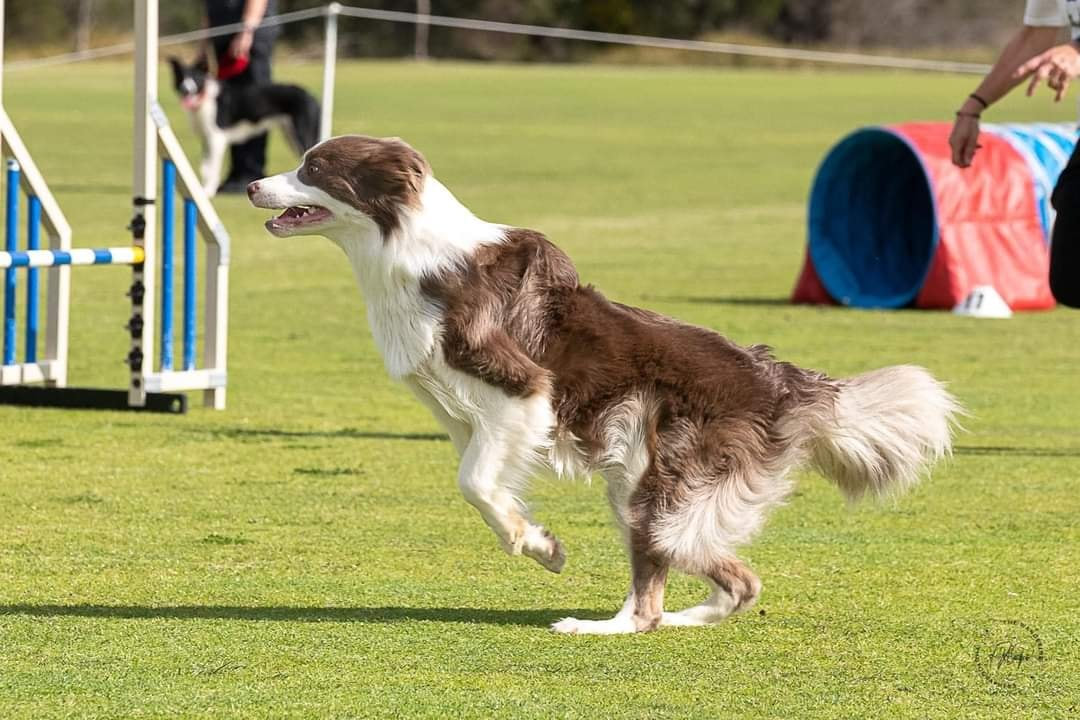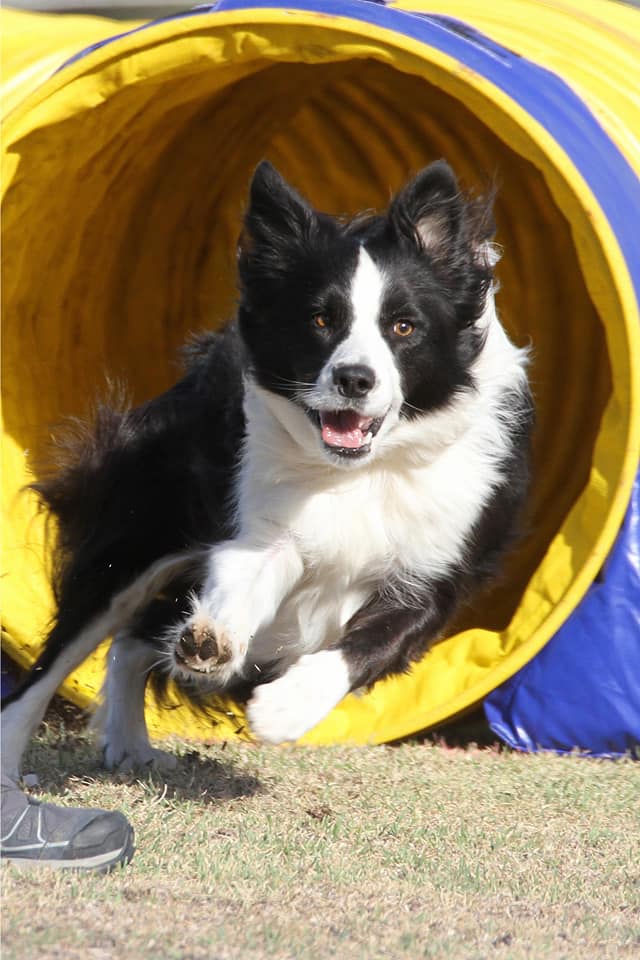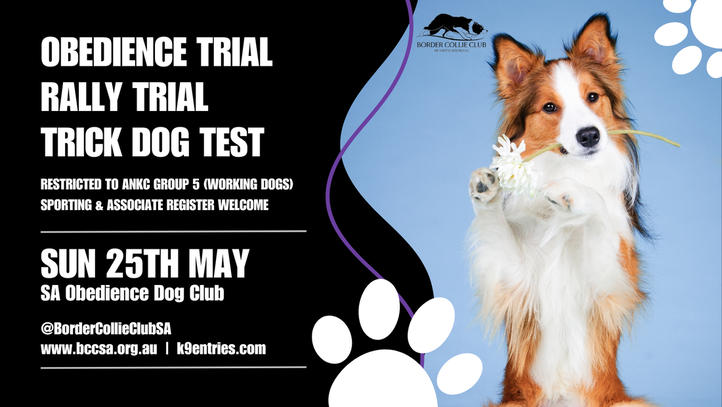Introduction to Agility
One of the most popular dog sports, Agility (and its associated events Jumping and Games) is a fun sport for dogs and handlers to get fit together and work as a team.
The sport was derived from equestrian show jumping however it could be argued that whoever made that choice had Border Collies in mind since their energy, intelligence, athleticism and speed are ideal for the sport and they're the first breed that usually springs to mind whenever someone mentions dog agility!
Dogs are required to negotiate an obstacle course through jumps, hoops, tunnels, weaving poles and 'contact' equipment such as A-frames, dog walks and see-saws within a Standard Course Time (SCT), and no faults. Contact equipment requires the dog to touch a coloured area at each end of the equipment. Obstacle jump heights suited to the dogs, based on the dog's height at the withers with jumps either 200, 300, 400, 500 or 600mm above the ground. Your dog will be officially measured and supplied with a height card. Whilst speed is desirable, steadiness is essential to ensure successful completion of the course.
A foundation in Obedience is essential as your dog will be working off-lead and will need to follow your instructions, sometimes at quite a distance. Team work is a major part of Agility, with the dog and handler working together to get the obstacles right, and of course celebrating their successes together as well. Skills that should be reliable as they are commonly used throughout the agility course are sits, drops, walking nicely on either side and stays/recalls.
The sport was derived from equestrian show jumping however it could be argued that whoever made that choice had Border Collies in mind since their energy, intelligence, athleticism and speed are ideal for the sport and they're the first breed that usually springs to mind whenever someone mentions dog agility!
Dogs are required to negotiate an obstacle course through jumps, hoops, tunnels, weaving poles and 'contact' equipment such as A-frames, dog walks and see-saws within a Standard Course Time (SCT), and no faults. Contact equipment requires the dog to touch a coloured area at each end of the equipment. Obstacle jump heights suited to the dogs, based on the dog's height at the withers with jumps either 200, 300, 400, 500 or 600mm above the ground. Your dog will be officially measured and supplied with a height card. Whilst speed is desirable, steadiness is essential to ensure successful completion of the course.
A foundation in Obedience is essential as your dog will be working off-lead and will need to follow your instructions, sometimes at quite a distance. Team work is a major part of Agility, with the dog and handler working together to get the obstacles right, and of course celebrating their successes together as well. Skills that should be reliable as they are commonly used throughout the agility course are sits, drops, walking nicely on either side and stays/recalls.
The difference between Agility, Jumping & Games:
Jumping and Games are Agility-based sports, with the equipment in jumping reduced to only various jumps, hoops and tunnels, whilst there are three different 'Games' on offer - Snooker, Gamblers and Strategic Pairs (a relay game where two dog-and-handler teams work together).
|
Jumping your dog too young or whilst unfit or overweight can cause damage to their joints, so whilst you can usually join Agility Foundations classes from 6 months and introduce obstacles without putting impact on their bodies (such as jumps/bars laid on the ground, tunnels, contacts at ground level), you won't begin to properly jump or use inline weaving poles with a healthy, fit dog until after 12 months old to protect their bodies. It is also advisable to purchase your puppy from a reputable breeder who will show you your puppy's parents' hip and elbow scores, and we recommend you also have your own dog's hips and elbows x-rayed and scored after 12 months old if you plan to participate in agility to ensure their risk of injury or the development of arthritis due to pre-existing issues is as low as possible.
|
Agility Obstacles
Clubs and private trainers have their own agility equipment used for training and trialling, however many people also like to build or buy equipment for training at home also. There are strict regulations on the measurements and suitability of obstacles used in agility. These are all outlined in the rules document, and focus primarily on the safety of the dog, so it is a good idea to stick to these regulations with any private equipment you purchase or make as well. All equipment must be sturdy, made of suitable materials and of a light colour unless otherwise specified in the description of that particular piece of equipment. There are to be no sharp edges or protrusions that may cause injury. All contact equipment requires an all-weather non-slip surface.
Agility Games Explained
SnookerA two-part game using both strategy and teamwork to score as many points as possible.
Opening Sequence: Begins with the opportunity to complete ‘red’ obstacles (always hurdles) for 1 point each. A successful red obstacle earns the opportunity to perform a ‘coloured’ obstacle, worth 2 to 7 points. A fault on a red obstacle (knocking the bar down) means another red must be performed. In each course there is a minimum of 3 and a maximum of 4 red obstacles, with only a maximum of 3 red obstacles allowed to be performed. At the judge's discretion, up to 3 obstacles in Excellent and up to 4 obstacles in Master can be combined to become one single coloured obstacle, called a 'Combination Obstacle'. Once a dog has started the combination obstacle it must be performed in its entirety.
The opening sequence ends when 3 red obstacles and the coloured obstacle following each successful red are completed. Each red obstacle may only be attempted once, however the same coloured obstacle may be used multiple times. If all but 1 of the red obstacles is faulted, only 1 coloured obstacle may be attempted before moving on to the closing sequence. If no red obstacles are completed successfully, the team receives no points and goes directly to the closing sequence. Closing Sequence: The team will perform all the coloured obstacles in sequence of their point value (remember the coloured obstacles were worth 2 to 7 points each), and earn the number of points assigned to each obstacle if they do not fault it. Scoring will cease at the signal given by the judge (such as a whistle) when: a fault occurs, an obstacle is performed out of numerical sequence, the last (#7) obstacle is performed, the allotted time expires, the dog starts any obstacle other than the first Closing Sequence obstacle after the end of the Opening Sequence, or the dog starts the Closing Sequence before completing 3 successful red + coloured combinations in the Opening Sequence. The dog must then go to the Finish Line to stop the clock - they’re disqualified otherwise! |
GamblersA two-part game showcasing a willingness and ability to work at a distance.
Point Accumulation Period: The aim is to accumulate as many points as possible during this period. The handler is allowed to lead out and the dog earns points for every obstacle successfully performed within a certain amount of time. Hurdles are worth 1 point, tunnels/hoops/broad jumps/4 weave poles and spread hurdles are worth 2 points, contact obstacles and 8 weave poles are worth 3 points, and 12 weave poles are worth 4 points. An obstacle can be performed any number of times but will only accumulate points for 2 correct negotiations. The judge will call out the point value for each obstacle after it is completed. There are no penalties for failing to negotiate an obstacle during this period, however if an obstacle is dislodged it becomes unavailable for both the Accumulation and Gamble Periods. The period ends when the timekeeper signals, at which point the Gamble Period begins.
The Gamble consists of a sequence of obstacles that requires the dog to work at a distance. Gamble Period: The dog is required to perform a series of obstacles ‘The Gamble’ within a certain amount of time and in the direction and sequence indicated by the judge. The dog is not penalised for negotiating obstacles when moving from the end of the Point Accumulation Period into the Gamble Period, however the scores do not count. Obstacle points begin at 2 points for the first obstacle and increase by 2 for each subsequent obstacle. Scoring will cease if a fault occurs during the Gamble. During this period, the handler is required to stay behind the Gamble line, and direct the dog from a distance. A signal from the timekeeper indicates the end of the Gamble Period. The time is stopped when the dog either crosses the finish line, or performs the finish obstacle. |
Strategic PairsA pairs relay - two dog and handler teams are on the course at the same time taking turns.
In Strategic Pairs, the course must be completed in numerical order, with teams taking turns to complete the course in the correct order. Teams can move anywhere on the course that they see fit and switch at any time, as many times as necessary or as strategically planned. There must be a minimum of two strategic exchanges.
The judge watches the ‘active’ obstacle and once it is performed correctly the next obstacle becomes active. Either dog may negotiate inactive obstacles out of sequence without being penalised. If one team faults on the active obstacle the other team must perform it, and if that team faults they must continue attempting it alternately until it is completed correctly however no penalty is recorded. If a bar gets knocked down it does not get reset but the dog still has to perform the obstacle (in this case it would be sent through the uprights). Handlers may talk to each other, and the course must be completed within the standard course time (SCT). |
Agility & Jumping Titles
There are titles available for each discipline across Agility, Jumping and Games, with five different classes in both Agility and Jumping - Novice, Excellent, Master, Elite and Open. We will discuss Games further down the page.
Agility Trials are open to dogs 18 months of age or over. Novice, Excellent and Master must be scheduled by the hosting club, and Open and Elite are optional. Where both Master and Elite are offered, a dog may not be entered in both however any dog entered in Novice, Excellent, Master or Elite can also enter the Open class, and all dogs in each height category will compete against each other across the same course, which is designed to a minimum of Excellent class standard.
To qualify (pass) the course must be completed within the Standard Course Time (SCT) without incurring any faults. This is called a Clear Round. There are course faults, time faults and penalty faults. Course faults are incurred for any mistake the dog makes, such as missing contact areas, dislodging any obstacle whilst navigating it, exiting through the side or landing on the boards of the broad jump, leaving the plank of the see saw before it has touched the ground, missing a gap when negotiating the weaving poles or refusing an obstacle. Each course has an SCT which is determined by the Judge measuring the total Course Length with a measuring wheel and dividing this by the Rate (speed of travel - determined by the judge as how quickly a dog should cover the distance, in metres per second). For example: If the course length (CL) is 120 metres and the Rate is 2 metres per second, then 120/2 = 60 seconds SCT. The dog would need to complete the set course in 60 seconds or less to avoid time faults. A time fault is recorded as the actual time over the SCT, so a dog who finished the above course in 62.87 seconds would receive 2.87 time faults. Penalty faults are more disciplinary faults and are incurred for things like not waiting for or following the judge's orders, the dog or handler misbehaving or breaching the rules, or reprimanding the dog either verbally or physically in the ring.
Titles are awarded in performance disciplines to dogs who achieve the required number of qualifying passes at each level and appear after the dog's name as a suffix. Only the highest title awarded to the dog will be used after their name, with each achievement superseding the one prior.
Champion titles can be awarded to dogs who have achieved their titles within the required Master class (see below) and go on to achieve the required number of points for qualifying runs in either the Master or Elite class. This title will appear before the dog's name as a prefix.
The titles represent and celebrate the hard work and training that has gone into achieving multiple qualifying pass results and the bond that has been built between dog and handler along the way.
Agility Trials are open to dogs 18 months of age or over. Novice, Excellent and Master must be scheduled by the hosting club, and Open and Elite are optional. Where both Master and Elite are offered, a dog may not be entered in both however any dog entered in Novice, Excellent, Master or Elite can also enter the Open class, and all dogs in each height category will compete against each other across the same course, which is designed to a minimum of Excellent class standard.
To qualify (pass) the course must be completed within the Standard Course Time (SCT) without incurring any faults. This is called a Clear Round. There are course faults, time faults and penalty faults. Course faults are incurred for any mistake the dog makes, such as missing contact areas, dislodging any obstacle whilst navigating it, exiting through the side or landing on the boards of the broad jump, leaving the plank of the see saw before it has touched the ground, missing a gap when negotiating the weaving poles or refusing an obstacle. Each course has an SCT which is determined by the Judge measuring the total Course Length with a measuring wheel and dividing this by the Rate (speed of travel - determined by the judge as how quickly a dog should cover the distance, in metres per second). For example: If the course length (CL) is 120 metres and the Rate is 2 metres per second, then 120/2 = 60 seconds SCT. The dog would need to complete the set course in 60 seconds or less to avoid time faults. A time fault is recorded as the actual time over the SCT, so a dog who finished the above course in 62.87 seconds would receive 2.87 time faults. Penalty faults are more disciplinary faults and are incurred for things like not waiting for or following the judge's orders, the dog or handler misbehaving or breaching the rules, or reprimanding the dog either verbally or physically in the ring.
Titles are awarded in performance disciplines to dogs who achieve the required number of qualifying passes at each level and appear after the dog's name as a suffix. Only the highest title awarded to the dog will be used after their name, with each achievement superseding the one prior.
Champion titles can be awarded to dogs who have achieved their titles within the required Master class (see below) and go on to achieve the required number of points for qualifying runs in either the Master or Elite class. This title will appear before the dog's name as a prefix.
The titles represent and celebrate the hard work and training that has gone into achieving multiple qualifying pass results and the bond that has been built between dog and handler along the way.
Class: Novice
Number of Obstacles (Agility): 14 - 16 with no limit to the amount of times an obstacle can be used, with the exception of the contact obstacles, spread hurdle and weaving poles which are to be used only once.
Mandatory Obstacles (Agility): Broad jump(s), dog walk, hoop(s), hurdle(s), spread hurdle, scramble, flexible tunnel(s), weaving poles.
Number of Obstacles (Jumping): 14 - 16 with no limit to the amount of times an obstacle can be used, with the exception of the spread hurdle which is to be used only once.
Mandatory Obstacles (Jumping): Broad jump(s), hoop, flexible tunnel(s), hurdle(s), spread hurdle.
Title Suffix: AD (Agility Dog) or JD (Jumping Dog)
Requirement: Five qualifying passes under at least three different judges.
This is the entry level of agility where courses are relatively short and you can test your training and communication with your dog. Don't be disheartened if you find it difficult to achieve a pass, agility is a sport that relies on everything going right but the up-side is that it's fun no matter what your results are! Your dog loves it, you get to run around together and there's always another trial.
Class: Excellent
Number of Obstacles (Agility): 16 - 20 with no limit to the amount of times an obstacle can be used, with the exception of the contact obstacles and weaving poles which are to be used only once.
Mandatory Obstacles (Agility): Broad jump(s), dog walk, hoop(s), hurdle(s), spread hurdle, scramble, seesaw, flexible tunnel(s), weaving poles.
Number of Obstacles (Jumping): 16 - 20 with no limit to the amount of times an obstacle can be used.
Mandatory Obstacles (Jumping): Broad jump(s), hoop, flexible tunnel(s), hurdle(s), spread hurdle.
Title Suffix: ADX (Agility Dog Excellent) or JDX (Jumping Dog Excellent)
Requirement: Six qualifying passes under at least three different judges.
This class for dogs who have qualified for their AD or JD title. It introduces the seesaw and may use the spread hurdle multiple times.
Class: Master
Number of Obstacles (Agility): 20 - 24 and all obstacles below must be performed, with weaving poles used only once.
Mandatory Obstacles (Agility): Broad jump(s), dog walk(s), hoop(s), hurdle(s), spread hurdle(s), scramble(s), seesaw(s), flexible tunnel(s), weaving poles.
Number of Obstacles (Jumping): 20 - 24 with no limit to the amount of times an obstacle can be used.
Mandatory Obstacles (Jumping): Broad jump(s), hoop, flexible tunnel(s), hurdle(s), spread hurdle(s).
Title Suffix: ADM (Agility Dog Master) or JDM (Jumping Dog Master)
Requirement: Seven qualifying passes under at least three different judges.
This class for dogs who have qualified for their ADX or JDX title and are working towards or have already achieved their ADM or JDM title. This is usually the highest class offered at most trials and is the step before the Agility Champion title. Multiplier suffixes may be awarded for multiples of seven certificates gained (example: 21 ADM qualifications becomes the suffix ADM3).
Class: Elite
Number of Obstacles (Agility): 22 - 28 with no limit to the amount of times an obstacle can be used. 12 weaving poles are mandatory once, with further repetitions able to be broken down into smaller numbers of poles.
Mandatory Obstacles (Agility): Broad jump(s), dog walk(s), hoop(s), hurdle(s), spread hurdle(s), scramble(s), flexible tunnel(s), 12 weaving poles.
Optional Obstacles (Agility): 4 to less than 12 weaving poles.
Number of Obstacles (Jumping): 22 - 28 with no limit to the amount of times an obstacle can be used.
Mandatory Obstacles (Jumping): Broad jump(s), hoop(s), flexible tunnel(s), hurdle(s), spread hurdle(s).
Title Suffix: ADE (Agility Dog Elite) or JDE (Jumping Dog Elite)
Requirement: Seven qualifying passes under at least three different judges.
This class is for dogs who have achieved their ADM or JDM title and are working towards or have achieved their ADE or JDE title. It should present more of a challenge than a typical Master course and shows the dog's exceptional performance ability. It is rarely offered at Agility Trials so the majority of eligible dogs will compete in the Master and/or Open classes. Multiplier suffixes may be awarded for multiples of seven certificates gained (example: 21 ADE qualifications becomes the suffix ADE3).
Class: Open
Number of Obstacles (Agility): 16 - 20 with no limit to the amount of times an obstacle can be used, with the exception of the contact obstacles and weaving poles which are to be used only once.
Mandatory Obstacles (Agility): Dog walk, hurdle(s), scramble, seesaw, flexible tunnel(s), weaving poles.
Optional Obstacles (Agility): Broad jump(s), spread hurdle(s), hoop(s).
Number of Obstacles (Jumping): 16 - 20 with no limit to the amount of times an obstacle can be used.
Mandatory Obstacles (Jumping): Broad jump(s), hoop(s), flexible tunnel(s), hurdle(s), spread hurdle(s).
Title Suffix: ADO (Agility Dog) or JDO (Jumping Dog)
Requirement: Six qualifying passes under at least three different judges.
This class is open to all dogs regardless of their title status. Dogs in each height category will compete against each other across the same course at an approximately Excellent level. It can be used to build confidence, test a dog's ability or simply offers competitors the opportunity to have another run, as agility is notoriously short with competitors usually spending only a minute or two in the ring. Multiplier suffixes may be awarded for multiples of six certificates gained (example: 18 ADO qualifications becomes the suffix ADO3).
Agility Champion
Title Prefix: AG. CH. + Height Category
If a dog having gained its ADM or JDM title continues to compete in either the Master or Elite class, they are awarded points for qualifying scores and placings (see table below). To achieve the title, at least 500 points must be awarded in each of Agility and Jumping and once a dog achieves 1000 points, they are eligible for the prefix title of Agility Champion, which will be listed before the name of the dog alongside the height category in which it was achieved (example: AG. CH. 500).
Number of Obstacles (Agility): 14 - 16 with no limit to the amount of times an obstacle can be used, with the exception of the contact obstacles, spread hurdle and weaving poles which are to be used only once.
Mandatory Obstacles (Agility): Broad jump(s), dog walk, hoop(s), hurdle(s), spread hurdle, scramble, flexible tunnel(s), weaving poles.
Number of Obstacles (Jumping): 14 - 16 with no limit to the amount of times an obstacle can be used, with the exception of the spread hurdle which is to be used only once.
Mandatory Obstacles (Jumping): Broad jump(s), hoop, flexible tunnel(s), hurdle(s), spread hurdle.
Title Suffix: AD (Agility Dog) or JD (Jumping Dog)
Requirement: Five qualifying passes under at least three different judges.
This is the entry level of agility where courses are relatively short and you can test your training and communication with your dog. Don't be disheartened if you find it difficult to achieve a pass, agility is a sport that relies on everything going right but the up-side is that it's fun no matter what your results are! Your dog loves it, you get to run around together and there's always another trial.
Class: Excellent
Number of Obstacles (Agility): 16 - 20 with no limit to the amount of times an obstacle can be used, with the exception of the contact obstacles and weaving poles which are to be used only once.
Mandatory Obstacles (Agility): Broad jump(s), dog walk, hoop(s), hurdle(s), spread hurdle, scramble, seesaw, flexible tunnel(s), weaving poles.
Number of Obstacles (Jumping): 16 - 20 with no limit to the amount of times an obstacle can be used.
Mandatory Obstacles (Jumping): Broad jump(s), hoop, flexible tunnel(s), hurdle(s), spread hurdle.
Title Suffix: ADX (Agility Dog Excellent) or JDX (Jumping Dog Excellent)
Requirement: Six qualifying passes under at least three different judges.
This class for dogs who have qualified for their AD or JD title. It introduces the seesaw and may use the spread hurdle multiple times.
Class: Master
Number of Obstacles (Agility): 20 - 24 and all obstacles below must be performed, with weaving poles used only once.
Mandatory Obstacles (Agility): Broad jump(s), dog walk(s), hoop(s), hurdle(s), spread hurdle(s), scramble(s), seesaw(s), flexible tunnel(s), weaving poles.
Number of Obstacles (Jumping): 20 - 24 with no limit to the amount of times an obstacle can be used.
Mandatory Obstacles (Jumping): Broad jump(s), hoop, flexible tunnel(s), hurdle(s), spread hurdle(s).
Title Suffix: ADM (Agility Dog Master) or JDM (Jumping Dog Master)
Requirement: Seven qualifying passes under at least three different judges.
This class for dogs who have qualified for their ADX or JDX title and are working towards or have already achieved their ADM or JDM title. This is usually the highest class offered at most trials and is the step before the Agility Champion title. Multiplier suffixes may be awarded for multiples of seven certificates gained (example: 21 ADM qualifications becomes the suffix ADM3).
Class: Elite
Number of Obstacles (Agility): 22 - 28 with no limit to the amount of times an obstacle can be used. 12 weaving poles are mandatory once, with further repetitions able to be broken down into smaller numbers of poles.
Mandatory Obstacles (Agility): Broad jump(s), dog walk(s), hoop(s), hurdle(s), spread hurdle(s), scramble(s), flexible tunnel(s), 12 weaving poles.
Optional Obstacles (Agility): 4 to less than 12 weaving poles.
Number of Obstacles (Jumping): 22 - 28 with no limit to the amount of times an obstacle can be used.
Mandatory Obstacles (Jumping): Broad jump(s), hoop(s), flexible tunnel(s), hurdle(s), spread hurdle(s).
Title Suffix: ADE (Agility Dog Elite) or JDE (Jumping Dog Elite)
Requirement: Seven qualifying passes under at least three different judges.
This class is for dogs who have achieved their ADM or JDM title and are working towards or have achieved their ADE or JDE title. It should present more of a challenge than a typical Master course and shows the dog's exceptional performance ability. It is rarely offered at Agility Trials so the majority of eligible dogs will compete in the Master and/or Open classes. Multiplier suffixes may be awarded for multiples of seven certificates gained (example: 21 ADE qualifications becomes the suffix ADE3).
Class: Open
Number of Obstacles (Agility): 16 - 20 with no limit to the amount of times an obstacle can be used, with the exception of the contact obstacles and weaving poles which are to be used only once.
Mandatory Obstacles (Agility): Dog walk, hurdle(s), scramble, seesaw, flexible tunnel(s), weaving poles.
Optional Obstacles (Agility): Broad jump(s), spread hurdle(s), hoop(s).
Number of Obstacles (Jumping): 16 - 20 with no limit to the amount of times an obstacle can be used.
Mandatory Obstacles (Jumping): Broad jump(s), hoop(s), flexible tunnel(s), hurdle(s), spread hurdle(s).
Title Suffix: ADO (Agility Dog) or JDO (Jumping Dog)
Requirement: Six qualifying passes under at least three different judges.
This class is open to all dogs regardless of their title status. Dogs in each height category will compete against each other across the same course at an approximately Excellent level. It can be used to build confidence, test a dog's ability or simply offers competitors the opportunity to have another run, as agility is notoriously short with competitors usually spending only a minute or two in the ring. Multiplier suffixes may be awarded for multiples of six certificates gained (example: 18 ADO qualifications becomes the suffix ADO3).
Agility Champion
Title Prefix: AG. CH. + Height Category
If a dog having gained its ADM or JDM title continues to compete in either the Master or Elite class, they are awarded points for qualifying scores and placings (see table below). To achieve the title, at least 500 points must be awarded in each of Agility and Jumping and once a dog achieves 1000 points, they are eligible for the prefix title of Agility Champion, which will be listed before the name of the dog alongside the height category in which it was achieved (example: AG. CH. 500).
Class |
Qualifying Pass in 1st Place |
Qualifying Pass in 2nd Place |
Qualifying Pass in 3rd Place |
Qualifying Pass |
Master |
25 |
20 |
15 |
10 |
Elite |
30 |
25 |
20 |
15 |
Games Titles
There are three classes available in each of the Games - Novice, Excellent and Master.
As in regular agility trials, games are open to dogs 18 months of age or over. Unlike regular agility trials, there are no 'refusals' and a dog is only considered to have 'started' an obstacle once they have placed a paw on a ramp, any part of their body crosses the jump line between the uprights, they jump over, run under or through a hurdle, or any part of the dog enters a tunnel or any part of the weave poles. A fault will then occur if a mistake is made after an obstacle has been started, for example entering the weave poles at a point other than between the first and second poles, or a dog whose paw has touched the coloured contact on the dog walk retracts that paw or dismounts before making contact with the coloured area at the other end.
As Strategic Pairs is a team relay and finding partners can be difficult, one dog of the pair may compete in the next height class above or below their own classification. Both dogs of the pair may compete in the next class above or below their classification providing that one dog is jumping above and one below their measured height class (for example a Border Collie usually in the 500 height category partnered with a Shetland Sheepdog usually in the 300 height category may compete together in the 400 Strategic Pairs). The judge will ensure that only obstacles used in the equivalent agility class will be used, and when a team qualifies each dog is awarded a certificate individually rather than as a team to allow them to compete in different trials with different partners as needed.
Champion titles can be awarded to dogs who have achieved their Master titles within each Game and go on to achieve a further 10 qualifying passes in each. This title will appear before the dog's name as a prefix.
As in regular agility trials, games are open to dogs 18 months of age or over. Unlike regular agility trials, there are no 'refusals' and a dog is only considered to have 'started' an obstacle once they have placed a paw on a ramp, any part of their body crosses the jump line between the uprights, they jump over, run under or through a hurdle, or any part of the dog enters a tunnel or any part of the weave poles. A fault will then occur if a mistake is made after an obstacle has been started, for example entering the weave poles at a point other than between the first and second poles, or a dog whose paw has touched the coloured contact on the dog walk retracts that paw or dismounts before making contact with the coloured area at the other end.
As Strategic Pairs is a team relay and finding partners can be difficult, one dog of the pair may compete in the next height class above or below their own classification. Both dogs of the pair may compete in the next class above or below their classification providing that one dog is jumping above and one below their measured height class (for example a Border Collie usually in the 500 height category partnered with a Shetland Sheepdog usually in the 300 height category may compete together in the 400 Strategic Pairs). The judge will ensure that only obstacles used in the equivalent agility class will be used, and when a team qualifies each dog is awarded a certificate individually rather than as a team to allow them to compete in different trials with different partners as needed.
Champion titles can be awarded to dogs who have achieved their Master titles within each Game and go on to achieve a further 10 qualifying passes in each. This title will appear before the dog's name as a prefix.
Game: Snooker
Class: Novice
Red Obstacles: Hurdles (1 Point)
Coloured Obstacles: Hurdle(s), dog walk, spread hurdle, flexible tunnel, hoop, scramble, broad jump, weave poles. No combination obstacle allowed in Novice.
Coloured Obstacle Points: Yellow = 2, Green = 3, Brown = 4, Blue = 5, Pink = 6, Black =7.
Minimum Opening Sequence Points: 10
Closing Sequence Points: 27
Title Suffix: SD (Snooker Dog)
Requirement: Three qualifying passes under at least two different judges.
This is essentially the 'entry level' Game, where the instructions are fairly simple and you can begin to build your strategic approach to agility by planning how to score the most points as quickly as possible. Remember: Opening Sequence = 1 x Red followed by 1 x Coloured - do this successfully three times. Closing Sequence = Perform all coloured obstacles in order.
Class: Excellent
Red Obstacles: Hurdles (1 Point)
Coloured Obstacles: Hurdle(s), dog walk, spread hurdle, flexible tunnel, hoop, scramble, seesaw, broad jump, weave poles. One combination obstacle allowed.
Coloured Obstacle Points: Yellow = 2, Green = 3, Brown = 4, Blue = 5, Pink = 6, Black =7.
Minimum Opening Sequence Points: 15
Closing Sequence Points: 27
Title Suffix: SDX (Snooker Dog Excellent)
Requirement: Four qualifying passes under at least two different judges.
This class is for dogs who have achieved their SD titles. The major changes in this class are the higher number of opening sequence points required and the addition of the seesaw.
Class: Master
Red Obstacles: Hurdles (1 Point)
Coloured Obstacles: Hurdle(s), dog walk, spread hurdle, flexible tunnel, hoop, scramble, broad jump, weave poles. Up to three combination obstacles allowed.
Coloured Obstacle Points: Yellow = 2, Green = 3, Brown = 4, Blue = 5, Pink = 6, Black =7.
Minimum Opening Sequence Points: 20
Closing Sequence Points: 27
Title Suffix: SDM (Snooker Dog Master)
Requirement: Five qualifying passes under at least three different judges.
This class is for dogs who have achieved their SDX title and is the highest level in Snooker requiring extremely competent strategic planning and execution to ensure success.
Red Obstacles: Hurdles (1 Point)
Coloured Obstacles: Hurdle(s), dog walk, spread hurdle, flexible tunnel, hoop, scramble, broad jump, weave poles. No combination obstacle allowed in Novice.
Coloured Obstacle Points: Yellow = 2, Green = 3, Brown = 4, Blue = 5, Pink = 6, Black =7.
Minimum Opening Sequence Points: 10
Closing Sequence Points: 27
Title Suffix: SD (Snooker Dog)
Requirement: Three qualifying passes under at least two different judges.
This is essentially the 'entry level' Game, where the instructions are fairly simple and you can begin to build your strategic approach to agility by planning how to score the most points as quickly as possible. Remember: Opening Sequence = 1 x Red followed by 1 x Coloured - do this successfully three times. Closing Sequence = Perform all coloured obstacles in order.
Class: Excellent
Red Obstacles: Hurdles (1 Point)
Coloured Obstacles: Hurdle(s), dog walk, spread hurdle, flexible tunnel, hoop, scramble, seesaw, broad jump, weave poles. One combination obstacle allowed.
Coloured Obstacle Points: Yellow = 2, Green = 3, Brown = 4, Blue = 5, Pink = 6, Black =7.
Minimum Opening Sequence Points: 15
Closing Sequence Points: 27
Title Suffix: SDX (Snooker Dog Excellent)
Requirement: Four qualifying passes under at least two different judges.
This class is for dogs who have achieved their SD titles. The major changes in this class are the higher number of opening sequence points required and the addition of the seesaw.
Class: Master
Red Obstacles: Hurdles (1 Point)
Coloured Obstacles: Hurdle(s), dog walk, spread hurdle, flexible tunnel, hoop, scramble, broad jump, weave poles. Up to three combination obstacles allowed.
Coloured Obstacle Points: Yellow = 2, Green = 3, Brown = 4, Blue = 5, Pink = 6, Black =7.
Minimum Opening Sequence Points: 20
Closing Sequence Points: 27
Title Suffix: SDM (Snooker Dog Master)
Requirement: Five qualifying passes under at least three different judges.
This class is for dogs who have achieved their SDX title and is the highest level in Snooker requiring extremely competent strategic planning and execution to ensure success.
Game: Gamblers
Class: Novice
Accumulation Period Time: 45 Seconds
Accumulation Period Points Required: 20
Accumulation Period Obstacle Points: Hurdle(s) = 1, Tunnel(s), hoop, broad jump, 4 weave poles, spread hurdle = 2, Dog walk, scramble, 8 weave poles = 3, 12 weave poles = 4.
Gamble Distance: 3 Metres
Gamble Obstacles Required: 4
Gamble Obstacles: Hurdles, flexible tunnel(s) x 2, broad jump.
Title Suffix: GD (Gamblers Dog)
Requirement: Three qualifying passes under at least two different judges.
Gamblers introduces distance work, with simple jumps and tunnels at Novice level at a short distance away from the dog.
Class: Excellent
Accumulation Period Time: 45 Seconds
Accumulation Period Points Required: 25
Accumulation Period Obstacle Points: Hurdle(s) = 1, Tunnel(s), hoop, broad jump, 4 weave poles, spread hurdle = 2, Dog walk, scramble, seesaw, 8 weave poles = 3, 12 weave poles = 4.
Gamble Distance: 5 Metres
Gamble Obstacles Required: 4 - 5
Gamble Obstacles: Hurdles, flexible tunnel(s) x 2, hoop, spread hurdle, broad jump, contact obstacle (scramble or dog walk).
Title Suffix: GDX (Gamblers Dog)
Requirement: Four qualifying passes under at least two different judges.
This class is for dogs who have achieved their GD titles and introduces more equipment at a further distance, whilst not yet tackling the most challenging obstacles during the gamble such as weave poles or the seesaw.
Class: Master
Accumulation Period Time: 45 Seconds
Accumulation Period Points Required: 30
Accumulation Period Obstacle Points: Hurdle(s) = 1, Tunnel(s), hoop, broad jump, 4 weave poles, spread hurdle = 2, Dog walk, scramble, seesaw, 8 weave poles = 3, 12 weave poles = 4.
Gamble Distance: 7 Metres
Gamble Obstacles Required: 5 - 7
Gamble Obstacles: Hurdles, flexible tunnel(s) x 2, 12 weave poles, hoop, spread hurdle, broad jump, contact obstacle (scramble, dog walk or seesaw).
Title Suffix: GDM (Gamblers Dog)
Requirement: Three qualifying passes under at least two different judges.
This class is for dogs who have achieved their GDX titles and is the highest level in Gamblers requiring a very high level of teamwork and effective communication between the dog and handler to be able to work at a large distance performing the most challenging course sequence and obstacles.
Accumulation Period Time: 45 Seconds
Accumulation Period Points Required: 20
Accumulation Period Obstacle Points: Hurdle(s) = 1, Tunnel(s), hoop, broad jump, 4 weave poles, spread hurdle = 2, Dog walk, scramble, 8 weave poles = 3, 12 weave poles = 4.
Gamble Distance: 3 Metres
Gamble Obstacles Required: 4
Gamble Obstacles: Hurdles, flexible tunnel(s) x 2, broad jump.
Title Suffix: GD (Gamblers Dog)
Requirement: Three qualifying passes under at least two different judges.
Gamblers introduces distance work, with simple jumps and tunnels at Novice level at a short distance away from the dog.
Class: Excellent
Accumulation Period Time: 45 Seconds
Accumulation Period Points Required: 25
Accumulation Period Obstacle Points: Hurdle(s) = 1, Tunnel(s), hoop, broad jump, 4 weave poles, spread hurdle = 2, Dog walk, scramble, seesaw, 8 weave poles = 3, 12 weave poles = 4.
Gamble Distance: 5 Metres
Gamble Obstacles Required: 4 - 5
Gamble Obstacles: Hurdles, flexible tunnel(s) x 2, hoop, spread hurdle, broad jump, contact obstacle (scramble or dog walk).
Title Suffix: GDX (Gamblers Dog)
Requirement: Four qualifying passes under at least two different judges.
This class is for dogs who have achieved their GD titles and introduces more equipment at a further distance, whilst not yet tackling the most challenging obstacles during the gamble such as weave poles or the seesaw.
Class: Master
Accumulation Period Time: 45 Seconds
Accumulation Period Points Required: 30
Accumulation Period Obstacle Points: Hurdle(s) = 1, Tunnel(s), hoop, broad jump, 4 weave poles, spread hurdle = 2, Dog walk, scramble, seesaw, 8 weave poles = 3, 12 weave poles = 4.
Gamble Distance: 7 Metres
Gamble Obstacles Required: 5 - 7
Gamble Obstacles: Hurdles, flexible tunnel(s) x 2, 12 weave poles, hoop, spread hurdle, broad jump, contact obstacle (scramble, dog walk or seesaw).
Title Suffix: GDM (Gamblers Dog)
Requirement: Three qualifying passes under at least two different judges.
This class is for dogs who have achieved their GDX titles and is the highest level in Gamblers requiring a very high level of teamwork and effective communication between the dog and handler to be able to work at a large distance performing the most challenging course sequence and obstacles.
Game: Strategic Pairs
Class: Novice
Obstacles: Hurdles, dog walk, spread hurdle, flexible tunnel, hoop, scramble, broad jump, weave poles.
Title Suffix: SPD (Strategic Pairs Dog)
Requirement: Three qualifying passes under at least two different judges.
Only obstacles used in Novice Agility are used, however there are approximately 20 - 25 obstacles in each course for the pairs to switch between strategically or as necessary. If you do not have a partner, many trials have the option to list that you are looking for a partner team to enter with - Pairs Dating!
Class: Excellent
Obstacles: Hurdles, dog walk, spread hurdle, flexible tunnel, hoop, scramble, seesaw, broad jump, weave poles.
Title Suffix: SPDX (Strategic Pairs Dog Excellent)
Requirement: Four qualifying passes under at least two different judges.
This class is for dogs who have achieved their SPD titles and includes the seesaw.
Class: Master
Obstacles: Hurdles, dog walk, spread hurdle, flexible tunnel, hoop, scramble, seesaw, broad jump, weave poles.
Title Suffix: SPDM (Strategic Pairs Dog Master)
Requirement: Five qualifying passes under at least three different judges.
This class is for dogs who have achieved their SPDX titles and is the highest level in Strategic Pairs requiring great teamwork between each pair to identify the best way through the course, which obstacles they should perform and when to switch to the other pair to finish in the fastest time possible.
Agility Games Champion
Title Prefix: AG. GAMES CH.
If a dog having gained its SDM, GDM and SPDM titles goes on to achieve a further 10 qualifying passes in each game, they are eligible for the prefix title of Agility Games Champion, which will be listed before the name of the dog.
Obstacles: Hurdles, dog walk, spread hurdle, flexible tunnel, hoop, scramble, broad jump, weave poles.
Title Suffix: SPD (Strategic Pairs Dog)
Requirement: Three qualifying passes under at least two different judges.
Only obstacles used in Novice Agility are used, however there are approximately 20 - 25 obstacles in each course for the pairs to switch between strategically or as necessary. If you do not have a partner, many trials have the option to list that you are looking for a partner team to enter with - Pairs Dating!
Class: Excellent
Obstacles: Hurdles, dog walk, spread hurdle, flexible tunnel, hoop, scramble, seesaw, broad jump, weave poles.
Title Suffix: SPDX (Strategic Pairs Dog Excellent)
Requirement: Four qualifying passes under at least two different judges.
This class is for dogs who have achieved their SPD titles and includes the seesaw.
Class: Master
Obstacles: Hurdles, dog walk, spread hurdle, flexible tunnel, hoop, scramble, seesaw, broad jump, weave poles.
Title Suffix: SPDM (Strategic Pairs Dog Master)
Requirement: Five qualifying passes under at least three different judges.
This class is for dogs who have achieved their SPDX titles and is the highest level in Strategic Pairs requiring great teamwork between each pair to identify the best way through the course, which obstacles they should perform and when to switch to the other pair to finish in the fastest time possible.
Agility Games Champion
Title Prefix: AG. GAMES CH.
If a dog having gained its SDM, GDM and SPDM titles goes on to achieve a further 10 qualifying passes in each game, they are eligible for the prefix title of Agility Games Champion, which will be listed before the name of the dog.
Helpful Links
If you are looking to trial, the most helpful resource available to you is the rules of the sport.
For the most up to date information or news, contact the Agility Advisory Committee.
For the most up to date information or news, contact the Agility Advisory Committee.
© Border Collie Club of South Australia Inc. 2025
